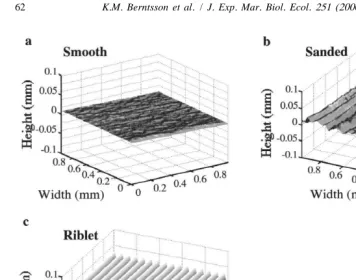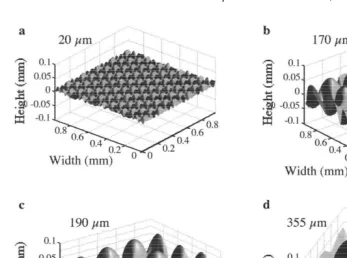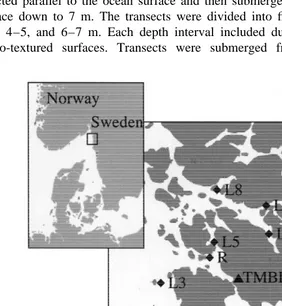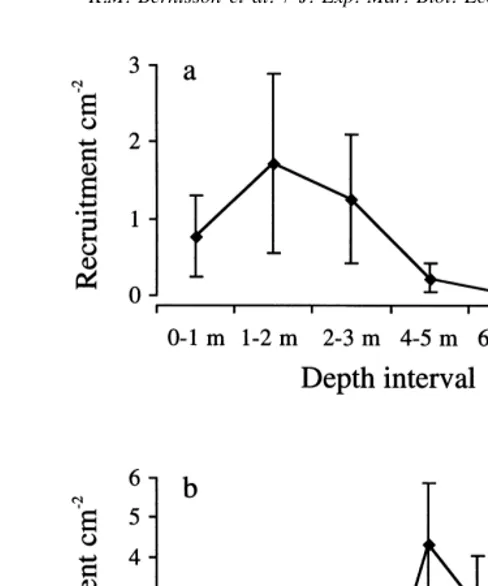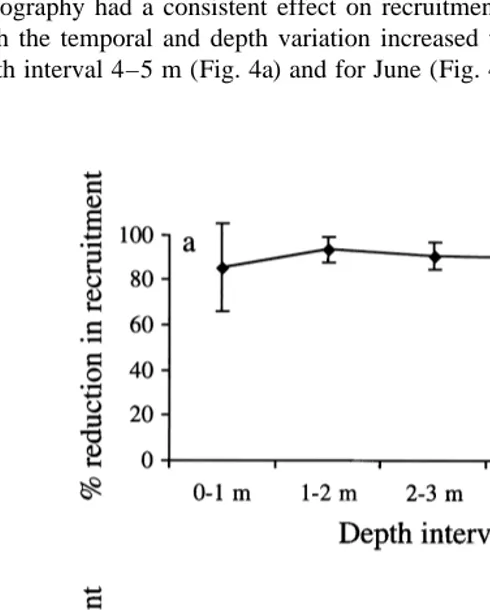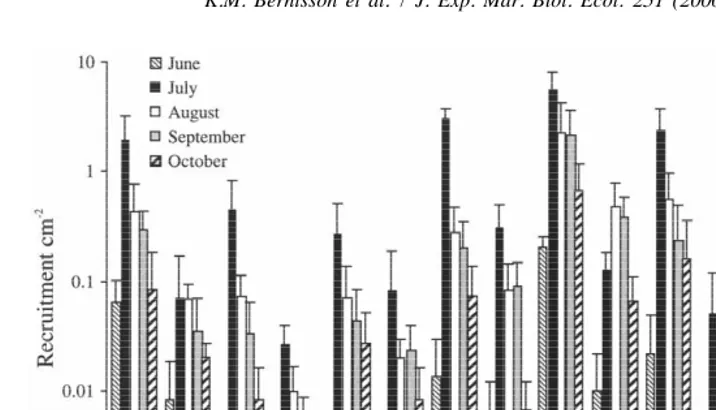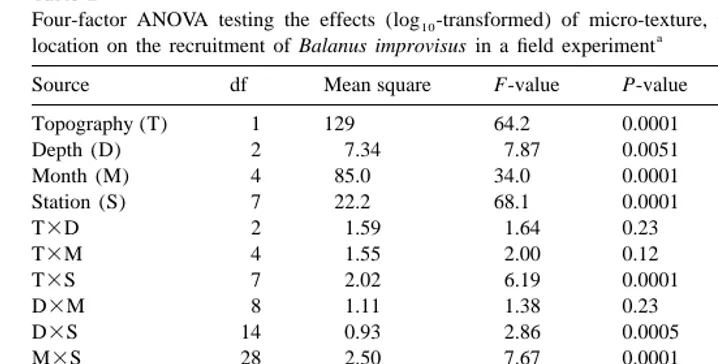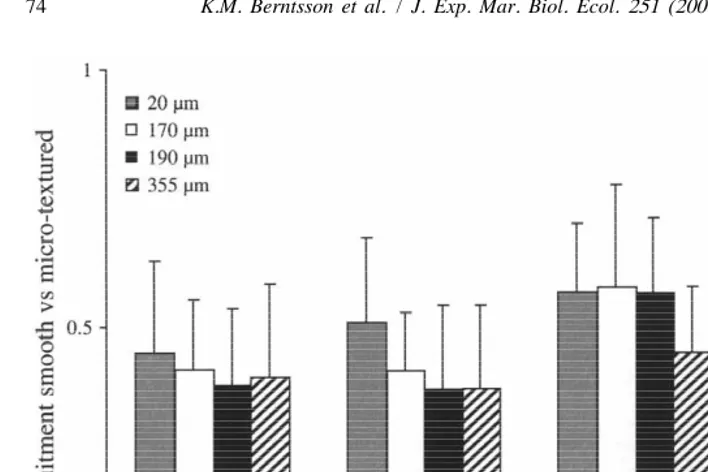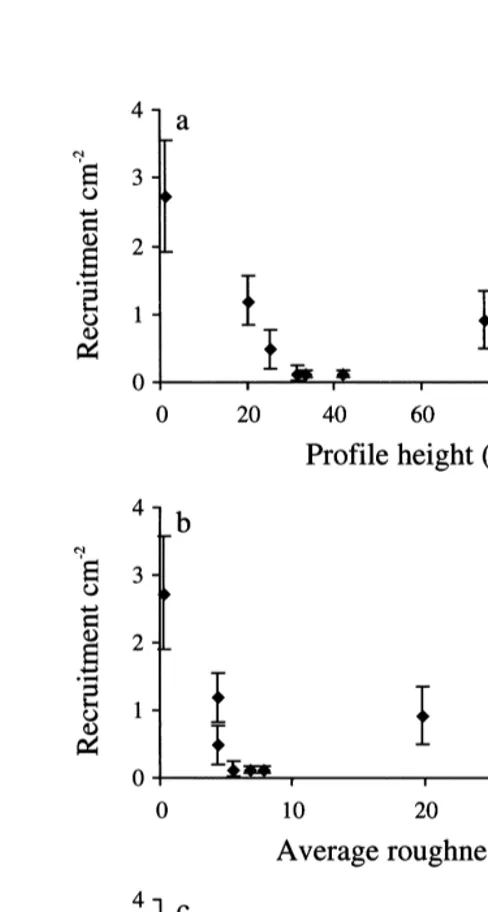251 (2000) 59–83
www.elsevier.nl / locate / jembe
Analysis of behavioural rejection of micro-textured surfaces
and implications for recruitment by the barnacle Balanus
improvisus
a ,* a a b
Kent M. Berntsson , Per R. Jonsson , Magnus Lejhall , Paul Gatenholm a
¨ ¨ ¨ ¨
Tjarno Marine Biological Laboratory, Goteborg University, SE-452 96 Stromstad, Sweden b
¨
Department of Polymer Technology, Chalmers University of Technology, SE-412 96 Goteborg, Sweden Received 20 September 1999; received in revised form 17 March 2000; accepted 18 March 2000
Abstract
Experiments performed in the field and in the laboratory show that the barnacle, Balanus
improvisus, preferentially settles on smooth surfaces. Settlement and recruitment of B. improvisus was evaluated on micro-textured surfaces with scales of surface texture ranging from 1 to 100mm in profile heights. Surface texture with profile heights within a topographic range of 30–45mm reduced settlement and recruitment by 92% as compared to smooth surfaces. The reduction in recruitment on micro-textured surfaces is best explained by behavioural responses to surface topography. Behavioural experiments show that cyprids have a higher propensity for smooth surfaces than for micro-textured surfaces. Cyprids spend more time exploring smooth surfaces and more time swimming when exposed to micro-textured surfaces. Micro-textured surfaces are more often rejected by cyprids after exploration than smooth surfaces. It is suggested that some scales of surface texture could be exploited to improve future anti-fouling techniques in geographical areas where Balanus improvisus is a severe fouling problem. 2000 Elsevier Science B.V. All rights reserved.
Keywords: Barnacle; Balanus improvisus; Micro-topography; Micro-texture; Recruitment; Settlement; Spatial and temporal variability; Larval behaviour; Micro-habitat selection; Biofouling; Antifouling
1. Introduction
Over the past two decades several mechanisms have been suggested to explain spatial and temporal patterns in barnacle recruitment (Caffey, 1985; Possingham and
Roughgar-*Corresponding author. Tel.:146-526-68-634; fax:146-526-68-607.
E-mail address: kent.berntsson@tmbl.gu.se (K.M. Berntsson).
den, 1990; Raimondi, 1990; Bingham, 1992; Pineda, 1994; Eckman, 1996). Patterns of large-scale recruitment have been explained by dispersal ability (Gaines and Bertness, 1992, 1993) larval supply (Connell, 1985; Gaines et al., 1985; Minchinton and Scheibling, 1991; Bertness et al., 1992), physical transport processes (Shanks and Wright, 1987; Tremblay et al., 1994; Shkedy and Roughgarden, 1997) and substrate availability for settling larvae (Pineda, 1994; Underwood and Anderson, 1994; Pineda and Caswell, 1997). On a smaller scale, larval behaviour has been invoked to explain variability in recruitment (e.g. Raimondi and Keough, 1990) where biological and physical factors can act as settlement cues. Biotic cues for settlement include the presence of conspecifics (Crisp, 1961; Barnett and Crisp, 1979; Wethey, 1984; Satchell and Farrell, 1993), bacterial films (Maki et al., 1988, 1990; Mary et al., 1993; Wieczorek et al., 1995; O’Connor and Richardson, 1996; Wieczorek and Todd, 1998) and microalgae (Raimondi, 1988a). Physical characteristics have also been suggested as important cues including flow regime (Mullineaux and Butman, 1991; Judge and Craig, 1997), and surface properties of the substrate (Anderson and Underwood, 1994) such as chemistry (Rittschof et al., 1984; Roberts et al., 1991; O’Connor and Richardson, 1994) and surface topography (Crisp and Barnes, 1954; Barnes, 1956; Crisp, 1961; Wethey, 1986).
In general, marine invertebrate larvae seem to settle more readily on rough as compared to smooth surfaces (Crisp, 1974). Surface topography in relation to larval settlement has often been characterised as texture (scales of surface irregularities below that of the size of the larva) and contour (scales of irregularities larger than that of the larva, Crisp and Barnes, 1954; Crisp, 1974; Le Tourneux and Bourget, 1988). Preferential settlement on surface contour structures such as cracks and pits by the barnacle Semibalanus balanoides has been shown by Crisp and Barnes (1954), Barnes (1956), Crisp (1961) and Wethey (1984, 1986). Crisp and Barnes (1954) termed such behaviour ‘rugotropism’ and suggested that tactile responses were involved. Hudon et al. (1983) studied the relative importance of texture, surface contour, primary film and gregariousness for settlement of Balanus crenatus larvae and found that surface texture proved to be more important than surface contour for B. crenatus settlement. Hills and Thomason (1998) showed that S. balanoides cyprids preferentially settles on tiles with surface texture in the range 0–0.5 mm indicating that larvae were attracted to surface-topography scales similar to their body size. The preference for rough surfaces has been ascribed to the need for a refuge with low shear stress and maximum adhesion (Walters and Wethey, 1996) or to prevent desiccation (Raimondi, 1990).
In contrast, few authors have reported any negative influence of surface topography on barnacle cyprid settlement and recruitment. Barnes and Powell (1950) found that glassfibre filaments with a diameter of 8 mm and a length of 1 mm were avoided by
Balanus crenatus larvae. Crisp and Barnes (1954) reported that cyprids of Semibalanus balanoides showed a greater tendency to swim off surfaces with ridges and convexities.
Several factors may explain differential settlement on rough and smooth surfaces, including adhesion strength, flux of larvae and larval behaviour. Crisp (1974) described the exploratory behaviour of cyprids as three subsequent phases, broad exploration, close exploration, and if a site on the surface is sufficiently attractive the larva enters the third inspection phase which precedes subsequent adhesion and metamorphosis. Le Tourneux and Bourget (1988) tried to determine factors used as cues by cyprids of Semibalanus
balanoides in the field and to classify these factors according to their relative importance
at each of the spatial scales examined by the larva during the three phases of settlement. They suggested that cyprids use a biological cue during broad exploration, sought for clean sites during close exploration and finally for heterogeneous micro-sites to ensure optimal adhesion during the inspection phase. The scale of surface microheterogeneity that cyprids preferred was of the order of 0.035–1 mm.
The barnacle Balanus improvisus is one of the major fouling organisms in Swedish waters and the settlement of this species has attracted recent interest from a fouling control perspective. The present study was conducted after preliminary observations that indicated that the settlement of B. improvisus was negatively influenced by surface texture (Andersson et al., 1999). This study is designed to test for settlement and recruitment responses to surface texture of different scales (height of texture elements (R )z 50–100 mm, width of texture elements (Rsm)50–500 mm) in relation to cyprid size (¯5503260mm) with the aim to identify critical size intervals of surface texture
for settlement. Furthermore, we present observations and analyses of cyprid behaviour as a function of surface topography and attempt to explain observed recruitment and settlement patterns as a function of behavioural differences shown by cyprids to surface topography.
2. Materials and methods
2.1. Manufacturing and characterisation of micro-textured surfaces
2.1.1. Manufacturing micro-textured surfaces
Seven surface-treatments were prepared, six on Plexiglas (medical grade PMMA) and one on poly-vinylidene-fluoride (PVDF). The micro-textures on PMMA were fabricated by a sanding (Fig. 1b) and a moulding procedure (Fig. 2a–d). The micro-texture on PVDF consisted of a film moulded with micro-riblets (Fig. 1c) and was developed and prepared by 3M Inc. (USA) as a drag-reducing surface for aeroplanes (This project is terminated and the PVDF riblet film is not available on the market).
Fig. 1. Topographic maps. (a) Smooth PMMA panel (untreated) used as a control (raster scan technique), (b) sanded PMMA panel (raster scan technique), (c) riblet film moulded in poly-vinylidene-fluoride. Scale units in mm.
remained smooth on both halves were heated in the same way but without plankton nets to avoid differences due to handling effects. The mesh size of the plankton nets used were 20, 170, 190, and 355 mm, respectively. The topographies of the sanded and moulded surfaces were analyzed as described below (Table 1, Figs. 1a–b and 2a–d).
Sanded PMMA panels were used in the first field study where recruitment on sanded panels was compared to smooth (untreated PMMA) panels (Section 2.2.1). Subdivided moulded PMMA panels with 1 section of the surface textured and the other smooth were used in the second field study to compare recruitment on surfaces with a settlement choice (Section 2.2.2). The PVDF riblet film was only used in the laboratory studies since the supply of the riblet film was limited (Section 2.3).
Fig. 2. Topographic maps of moulded PMMA panels manufactured from different mesh-sizes of plankton nets. Maps are based on the raster scan technique using a stylus tip: (a) 20mm mesh, (b) 170mm mesh, (c) 190
mm mesh, (d) 355mm mesh. Scale units in mm.
Inc.) was glued onto one half of the bottom surface of a Petri dish and included as a treatment.
Behaviour (Section 2.3.2) was recorded on 30330 mm areas of all the surface treatments in Petri dishes.
Table 1
Roughness profiles (mean695% CI) of all panel treatments evaluated in this study (The roughness parameters calculated are R (average roughness of the profile), R (maximum height of the profile) and Ra z sm(mean width of profile elements)
Surface R (ma m) R (mz m) Rsm(mm) a
Smooth 0.2060.04 1.2260.23 112633.5 a
20-mm 4.3860.16 20.361.18 82.568.15 a
170-mm 19.960.49 74.561.03 23161.55 a
190-mm 30.160.41 10163.28 29761.67 a
355-mm 28.863.41 99.9613.7 50363.58 b
Riblet 64 64
c
Sandpaper 6.1362.40 32.9611 204693.7 a
Within panel variability, n52. b
Regular texture with dimensions from the manufacturer (3M Inc.). c
2.1.2. Analysis of surface topography
Assessment of surface texture and contour was made by the raster scan technique that uses a 3D surface-measuring device (Surfascan 3D, Somicronic). This is a mechanical stylus-scanning profilometer generating 3D maps by making a number of parallel profiles on the surface and then storing them in a raster scan for analysis on a PC. The
2
traversing of the surface was obtained by an X –Y table over an area of 2.532.5 mm and sampling distances in multiples of 2mm producing 256 data points in each direction. The stylus has a cone-shaped diamond tip of 908 and a radius of 2 mm. The vertical measuring range had a resolution of 5.2 nm (Ohlsson, 1995). Measurement velocity was
21
0.5 mm s and the data was dynamically collected ‘on-the-fly’.
The roughness or R-parameters were calculated with a digital Gaussian filter according to a standardized method (EN ISO 4287:1998, 1998) where a cut-off wavelength (lc) of 0.8 mm was applied. The chosen roughness parameters were the amplitude parameters R (the arithmetic mean of the absolute ordinate values within aa
sampling length, also termed average roughness) and R (the sum of the largest profilez
peak height and the largest profile valley depth within a sampling length) and finally the spacing parameter Rsm (the mean value of the profile element widths within a sampling length) (EN ISO 4287:1998, 1998).
Profile measurements were made after the panels had been exposed for 4 weeks at the test stations. Prior to measurements panels were submerged in detergent with citric acid (280 ml Extran AP22, pH 2.21, in 3.5 l H O) for 24 h and then washed and rinsed in2
fresh water. Since surface texture on sanded PMMA panels was expected to show some variation both within and between panels roughness profiles were assessed on four
2
replicate panels with three sample areas (2.532.5 mm ) from each panel. Microscopic investigation of surface texture on moulded PMMA panels showed no or minor variation within and between panels and only one moulded PMMA panel from each treatment
2
(20, 170, 190, and 355mm) was measured with two sample areas (2.532.5 mm ) from each panel. Assessment of the surface micro-texture on moulded panels also included the smooth panel treatment that was heated in the oven but not micro-textured. The surface texture of the PVDF riblet film used in the laboratory studies as described in Section 2.1.1 was not measured in this study since the regular profile was known from the manufacturer (Table 1, 3M Inc.).
2.1.3. Analysis of surface chemistry
The elementary chemical composition of the PMMA panel surface was analysed for all treatments with electron spectroscopy for chemical analysis (ESCA) using a Perkin-Elmer PHI 5500 with a Mg Ka X-ray source. This technique is a surface sensitive method with a penetration depth below 10 nm. ESCA was used to obtain quantitative data on surface element composition to detect potential impurities or modifications at the surface due to the sanding and moulding process.
2.2. Field studies of Balanus improvisus recruitment on micro-textured surfaces
¨ ¨
surfaces were performed at Tjarno Marine Biological Laboratory (TMBL) on the west coast of Sweden (588539N, 11889E, Fig. 3).
2.2.1. Recruitment on smooth and micro-textured surfaces
In the first field study, recruitment on sanded PMMA panels was compared with smooth PMMA panels (Table 1, Figs. 1a and 1b). Panel surface treatments were replicated at different depths and time intervals to cover the major settlement distribution of B. improvisus on the Swedish west coast (Fig. 4a and b) and within-station, horizontal replication was included to estimate residual variance. Test panels were fixed with control and sanded panels interspersed on vertical transects with grooves and ridges directed parallel to the ocean surface and then submerged to different depths from the surface down to 7 m. The transects were divided into five depth intervals, 0–1, 1–2, 2–3, 4–5, and 6–7 m. Each depth interval included duplicate panels of smooth and micro-textured surfaces. Transects were submerged from buoys situated at eight
Fig. 3. Map showing the field test sites on the west coast of Sweden. Locations marked L1–L8 were used in the study of recruitment on sanded PMMA panels. The location R was used to study recruitment on moulded
¨ ¨
Fig. 4. Recruitment (mean695% CI) of B. improvisus on smooth PMMA panels between 0 and 9 m depth at monthly intervals from February to December 1997 averaged over eight locations. (a) Recruitment as a function of depth (n540), (b) recruitment as a function of month at 0–3 m depth (n548).
randomly selected stations (each station approximately 1 km apart) around the island of ¨ ¨
Tjarno (Fig. 3), covering spatial variations in flow regime and possibly supply of competent cyprids. Panels were submerged for 4 weeks at each station, then collected for analysis and replaced with new panels. To test for temporal differences in settlement this procedure was repeated monthly (n55) during the settlement season from June until October 1998. The number and species of attached cyprids and metamorphosed juveniles were determined using a dissecting microscope. To avoid possible edge effects, individuals attached within 1 cm from the panel edge were not counted.
2.2.2. Choice experiment on subdivided PMMA panels
smooth control and subdivided micro-textured panels. Frames were submerged from a stationary raft located in a 15-m deep bay with weak water currents close to TMBL (Fig. 3). After an exposure time of 4 weeks attached cyprids and metamorphosed juveniles on the panels were identified to species and counted (excluding individuals attached within 1 cm from the panel edge). This procedure was repeated monthly (n54) from July until October 1998 to test for temporal differences. Recruitment was compared among panel treatments and between the sections of each panel. To ensure independence of samples, only barnacles attached to the micro-textured part of the panels were counted in the among panel comparison. In this analysis smooth control panels were also divided into two parts along the panel diagonal and barnacles were counted on one of the randomly chosen parts. Analysis of recruitment between the sections of each panel was performed by testing the proportion of barnacles on the smooth part. Settlement intensity is
22
presented as number of individuals cm .
2.3. Cyprid settlement and behaviour on micro-textured surfaces
2.3.1. Cyprid settlement in choice experiments
Cyprids were reared in a laboratory culture system. Adults of Balanus improvisus were fed a daily mixture of Artemia sp. and Isochrysis galbana. Released nauplii were collected on sieves (60 mm) through an overflow and then transferred to 20-l buckets
21
and kept at a density of |1 larva ml . Cultures were maintained at 27618C, in filtered
seawater (0.2mm) that was stirred by aeration and changed every third day. At the start of each larval batch and at the time of water exchange, each bucket was supplied with
21
fresh microalgae and antibiotics (streptomycin 36.5 mg l and penicillin G 21.9
21 21
mg l ). The diet fed to the developing nauplii consisted of 200 cellsml of 21
Thalassiosira pseudonana mixed with 100 cellsml of I. galbana. As cyprids had moulted after 6 days in the buckets, the cultures were sieved (200mm) and cyprids were removed for subsequent experiments. Linear dimensions of the reared cyprids were: cyprid length 530–580mm, cyprid width 250–270mm, antennular length 220–240mm, antennular disc diameter 20–25 mm.
To evaluate cyprid settlement as a function of surface texture, cyprids were offered a settlement choice in sterile polystyrene petri dishes with circular PMMA pieces divided into a smooth and a micro-textured section glued onto the dish (described in Section 2.1.1). The surface treatments consisted of seven different micro-textures: four moulded PMMA panels (20, 170, 190, and 355 mm), sanded PMMA, the PVDF film with moulded micro-riblets and finally an untreated Petri dish polystyrene surface as a smooth control (Table 1, Figs. 1 and 2). All types of surfaces were aged for 2 days in freshwater prior to the settlement experiment.
Cyprids harvested from larval cultures on day 0 after moulting were used to test for the propensity of settlement on surfaces with different micro-textures. Each of the seven treatments was replicated in four containers. Containers with 10 ml of sterile-filtered seawater (30‰) were supplied with 20 cyprids, added to the containers in random order from a bowl with|5000 individuals, and were maintained at 228C in an incubation box.
microscope. Procedures in counting and analysis of settlement on the micro-textured surfaces and smooth controls were identical to those described for the settlement choice experiments in the field.
2.3.2. Analysis of the settlement behaviour as a function of micro-texture
Cyprid behaviour was recorded with a video-camera (Panasonic F15) connected to a dissecting microscope (Wild M5, 63) as cyprids were moving on surfaces with different micro-textures. Seven micro-textured surfaces were applied to the bottom of petri dishes (Section 2.1.1): untreated polystyrene (petri dish), four textures of moulded PMMA (20, 170, 190, and 355mm), sanded PMMA, and the riblet film. The behaviour of cyprids was recorded in an enclosed section of the surface (enclosed with an arena 25325310 mm) on each type of surface treatment. Cyprids that performed surface exploration in the storage bowl were haphazardly collected (from |5000 individuals)
and transferred one at a time to the surface treatment to be tested. Recordings started when a cyprid made its first attempt to explore the surface and subsequent behaviour was carefully tracked and recorded for 5 min.
Cyprid behaviour was recorded for 15 separate individuals on each type of surface and the surfaces were washed in EtOH (70%) and distilled water between recordings. The behaviours observed on each type of surface were divided into two main categories: cyprids exploring the surface and cyprids swimming. Surface exploration was further divided into three exploratory phases: broad exploration, close exploration and inspec-tion as described by Crisp (1974). Broad explorainspec-tion was characterised by larvae ‘walking’ with large step lengths over the surface in a more or less straight path with infrequent turns and few halts. Close exploration was characterised by larvae ‘walking’ with short step lengths and frequent changes of direction and many short halts to test the adhesion strength between the antennular discs and the surface. Inspection was characterised by larvae remaining in one spot in which they could move or rotate without moving the antennules, presumably testing the adhesion strength between the antennular discs and the surface. Swimming in this experiment included all other behaviours where cyprids had no contact between the antennules and the surface, i.e. cyprids swimming by beating their thoracic appendages or cyprids remaining inactive on their dorsal or lateral side. The duration of these behaviours was measured with a timer from the video recordings (time budget of behaviours during the 5-min interval). The time budgets were tested in two ways. First, in a comparison between exploring and swimming behaviour the proportion of time spent exploring was tested between smooth and textured surfaces. Secondly, we tested if inspection behaviour, being an indicator of settling propensity, differed between smooth and textured surfaces.
2.4. Statistical methods
depth of submersion (‘depth’) and monthly interval of submersion (‘month’). Topog-raphy, depth and month were considered as fixed factors and station was considered as a random factor. In the analyses of choice experiment on subdivided Plexiglas (Section 2.2.2.) the orthogonal factors were ‘topography’ and ‘month’ and they were considered as fixed. Differences in settlement and behaviour (Sections 2.3.1 and 2.3.2) between surface treatments were analysed by one-factor ANOVA. A posteriori comparisons were performed using Student–Newman–Keuls procedure and tests for homogeneity of variances were performed using Cochran’s test (Winer et al., 1991). All data sets, except the proportion of settlers on smooth versus micro-textured sections (Section 2.2.2) and the behavioural time budgets (Section 2.3.2), showed heteroscedasticity and were therefore log-transformed (log ) prior to the analysis of variance (ANOVA). This also10
implies that interactions among factors should be interpreted on a proportional scale. In both field experiments (Section 2.2) the data were log-transformed as log(recruitment1
0.0001) and the micro-textured treatments were tested against the smooth controls. In the laboratory study (Section 2.3.1) the data were log-transformed as log(settlement10.1) and settlement on textured treatments were tested against settlement on untreated petri dish controls. Laboratory data on behavioural time-budgets (Section 2.3.2) were tested using a one-factor ANOVA, and a priori means comparison contrasts for tests of surface texture against the smooth control.
3. Results
3.1. Characterisation of micro-textured surfaces
3.1.1. Analysis of surface topography
Table 1 shows the roughness parameters R , Ra z and Rsm for the tested surface textures. The roughness parameters on smooth PMMA panels used as controls were clearly different as compared to sanded panels (Table 1, Figs. 1a and 1b). The average roughness of the profile (R ) was 28 times larger, the maximum height of the profile (R )a z
27 times larger and the mean width of the profile elements (Rsm) 18 times larger on sanded panels as compared to smooth panels. There were large differences in the roughness parameters between the moulded panels with substantial increase in R and Ra z
parameters from smooth ,20,170,190¯355 mm (Table 1). The Rsm parameter
showed a similar increase except that the width of the profile elements did not differ between smooth and 20 mm panels (Table 1, Fig. 1a and Fig. 2a–d). The roughness parameters for the PVDF riblet film (Fig. 1c) given by the manufacturer (3M Inc.) is shown in Table 1.
3.1.2. Analysis of surface chemistry
the panels during the sanding and moulding procedure. The levels of Si were not apparently affected by the heating procedure in the oven.
3.2. Field studies of Balanus improvisus recruitment on micro-textured surfaces
3.2.1. Recruitment on smooth and micro-textured surfaces
Over all depths, months and stations the mean recruitment of B. improvisus was reduced by 82611% (n55) on micro-textured surfaces as compared to smooth controls in the field experiments. Fig. 5a shows the reduction in recruitment as a function of topography and depth in July and Fig. 5b shows the reduction in recruitment as a function of topography and month averaged for all stations. These two graphs suggest that topography had a consistent effect on recruitment irrespective of depth and month although the temporal and depth variation increased when settlement was low, e.g. for the depth interval 4–5 m (Fig. 4a) and for June (Fig. 4b). Recruitment on sanded panels
Fig. 6. Recruitment (mean695% CI, n56) of B. improvisus on smooth (S) and sanded (T) PMMA panels for different locations and months averaged over the depth interval 0–3 m. Y-axis on a logarithmic scale.
as a function of topography, month and station, averaged for the top three depth intervals (0–3 m) was consistently low during the whole settlement period (Fig. 6). During peak
22
settlement in July (mean recruitment52.660.7 ind. cm on smooth panels and 22
50.160.03 ind. cm on sanded panels, Fig. 6) recruitment was reduced by 9268% on sanded panels as compared to controls (Fig. 5b). In June when the mean recruitment was
22 22
as low as 0.0560.02 ind. cm on smooth and 0.00460.002 ind. cm (Fig. 6) on sanded panels, recruitment on sanded surfaces was still reduced by 68636% although the variation among stations and depths was more pronounced compared to subsequent months (Fig. 5b). The major source of the variation in recruitment on smooth surfaces is due to differences in recruitment among stations (Fig. 6). For instance the recruitment on smooth surfaces including the top three depth intervals (0–3 m) and all five months was
22 22
2.260.5 ind. cm in station L5 and 0.0860.05 ind. cm in station L3 (Fig. 6). Despite this spatial variation the difference in recruitment between smooth and micro-textured surfaces was very consistent (Fig. 6).
Table 2
Four-factor ANOVA testing the effects (log -transformed) of micro-texture, time of exposure, depth and10 a
location on the recruitment of Balanus improvisus in a field experiment
Source df Mean square F-value P-value Error term
Topography (T) 1 129 64.2 0.0001 T3S
Depth (D) 2 7.34 7.87 0.0051 D3S
Month (M) 4 85.0 34.0 0.0001 M3S
Station (S) 7 22.2 68.1 0.0001 Residual
T3D 2 1.59 1.64 0.23 T3D3S
T3M 4 1.55 2.00 0.12 T3M3S
T3S 7 2.02 6.19 0.0001 Residual
D3M 8 1.11 1.38 0.23 D3M3S
D3S 14 0.93 2.86 0.0005 Residual
M3S 28 2.50 7.67 0.0001 Residual
T3D3M 8 0.30 0.57 0.80 T3D3M3S
The treatment ‘Topography’ included sanded and smooth panels. The treatment ‘Depth’ included the three intervals 0–1, 1–2, and 2–3 m. The treatment ‘Month’ consisted of five subsequent months with panels exposed for 1 month. The location factor ‘Station’ included eight randomly selected locations.
3.2.2. Choice experiment on subdivided PMMA panels
Compared to smooth controls all micro-textured surfaces reduced recruitment to a similar degree (Fig. 7). Peak settlement occurred in August and the mean recruitment on
22
smooth controls was 1.460.7 ind. cm while subdivided 190mm panels had the lowest 22
recruitment with 0.260.1 ind. cm (Fig. 7). The effect of topography was general, irrespective of monthly interval (Table 3), although no statistical difference in recruitment between panels with different sizes of micro-texture was detected (SNK,
P.0.05).
A choice situation was included within each panel where cyprids could choose to settle on a micro-textured part or a smooth part of the panel. The distribution of barnacles between these parts of the panel were not as obvious as expected from the among panel analysis. There was no significant difference in the proportion of barnacles that settled on the smooth part of the panel as compared to the micro-textured part (two-factor ANOVA, F3,11251.0, P.0.05), although more barnacles settled on the smooth part in July and August compared to September and October (Fig. 8, two-factor ANOVA, F3,11254.3, P,0.05, SNK, P,0.05). This fraction varied considerably both within and among treatments and between monthly interval (Fig. 8).
Fig. 7. Recruitment (mean695% CI, n58) of B. improvisus on panels with different scales of micro-texture compared to a smooth control in August 1998. The sizes in the graph refer to the mesh-size used to mould each textured surface. For measured topographic dimensions see Table 1.
roughness (R ) within 5–10a mm (Fig. 9b) and a roughness width (Rsm) within 150–200
mm (Fig. 9c).
3.3. Cyprid settlement and behaviour on micro-textured surfaces
3.3.1. Cyprid settlement in choice experiment
Micro-textured surfaces, as in the field experiment, significantly reduced settlement as compared to smooth controls (Fig. 10, one-factor ANOVA, F6,21541.0, P,0.05), although no differences between different scales of roughness were detected (SNK,
P.0.05). Treatments with the riblet-film and mouldings from 170 and 355mm plankton nets, however, completely inhibited settlement (Fig. 10). The distribution of settled cyprids on the subdivided surfaces in the laboratory study was less variable than in the field experiment. The only treatments where any cyprids settled on the micro-textured
Table 3
Two-factor ANOVA testing the effects (log -transformed) of micro-texture and time of exposure on the10 a
recruitment of Balanus improvisus in a field experiment
Source df Sum of squares Mean square F-value P-value
Topography (T) 4 6.42 1.60 9.65 0.0001
Month (M) 3 19.3 6.45 38.8 0.0001
T3M 12 2.14 0.18 1.07 0.39
Residual 140 23.3 0.17
a
Fig. 8. The fraction (mean695% CI, n58) of B. improvisus recruits on the smooth compared to the micro-textured part of moulded PMMA panels. The legend refers to the four micro-textures tested. Fractions below 0.5 indicate that the majority of barnacles were found on the smooth section.
portion of the surfaces were on 20, 190mm and sanded panels although the fraction that settled onto the smooth portion was still high 70, 80 and 80%, respectively. Cyprids appeared more selective about their settlement site in the laboratory as compared to the field and the proportion settled on the smooth part of the panels was significantly higher in the laboratory experiments (two-factor ANOVA, F1,24554.0, P,0.05).
3.3.2. Analysis of settlement behaviour as a function of micro-texture
Video-recording and analysis of cyprid exploratory behaviour on different topographic surfaces revealed a strong effect of micro-texture on cyprid behaviour. When comparing the two main categories of cyprid behaviour surface exploration and swimming, there was an obvious pattern where cyprids spent more time exploring on smooth surfaces than on micro-textured surfaces (Fig. 11). The proportion of time that cyprids spent exploring the surface differed between the smooth control and all micro-textured surfaces except for the moulded 190-mm treatment (one-factor ANOVA, F6, 9855.1,
P,0.05). There was, however, no significant difference in the proportion of time exploring between different scales of micro-texture (Fig. 11, SNK, P.0.05).
Fig. 10. Settlement (mean695% CI, n55) of B. improvisus cyprids as a function of different micro-textures, including a smooth control, in a laboratory experiment. For topographic dimensions see Table 1.
nificantly less time inspecting the textured surfaces compared to the smooth control (means comparison contrast F1,9854.3, P,0.05). It is interesting to note, however, that the distribution of cyprid exploratory phases on the moulded 20-mm surface resembled
Fig. 12. Time budgets (mean695% CI, n515) of cyprid behaviour on surfaces with different micro-textures, including a smooth control. B. improvisus cyprids were recorded for 5 min and their behaviour was divided into three different exploration phases. For topographic dimensions see Table 1.
the distribution on smooth surfaces (Fig. 12). The time budgets of the exploratory phases changed and some phases even disappeared on surfaces with larger structures as compared to the smooth surface, e.g. close exploration was absent on the moulded 170-mm surface and broad exploration was absent on the moulded 355-mm surface (Fig. 12). Broad exploration was most frequent on the moulded 190-mm surface and the riblet surface (Fig. 12). Close exploration was more frequent on the smooth surface as compared to moulded 170-mm, moulded 355-mm and sanded surfaces (Fig. 12). Cyprids allocated more time to inspection behaviour on moulded 355-mm than on moulded 170-mm, moulded 190-mm surfaces and the riblet surface, and inspection was more common on the smooth surface than the riblet surface.
Exploration behaviour appeared to be somewhat different on sanded and moulded 170-mm, and 355-mm surfaces compared to other micro-textured treatments. Cyprids tended to progress from swimming behaviour to inspection with the preceding exploratory phases shortened or absent. On moulded 170-mm surfaces cyprids went straight from broad exploration to inspection without performing close exploration. Finally, it is worth emphasizing that although the sampling of behaviours started when the cyprids made the first contact with the substrate, most micro-textured surfaces were rejected before the end of each recording sequence which demonstrates the cyprids’ aversion against textured surfaces, at least within the scales covered by this study.
4. Discussion
4.1. Recruitment as a function of topography
The sanding and moulding procedures changed the surface chemistry of the PMMA panels only very slightly and reductions in settlement and recruitment can be interpreted as caused by the differences in surface topography. Field exposure of panels with different surface textures showed a clear negative effect of texture on the recruitment of
Balanus improvisus. This effect was particularly strong for sanded panels where the
maximum reduction in recruitment after 1 month was over 92% as compared to smooth controls. This effect was surprisingly consistent for different depths and time of the year. A similar reduction in settlement was also evident in a series of laboratory experiments. Recruitment on moulded, micro-textured panels was significantly less as compared to smooth controls, although the effect of texture was less than for sanded panels. The reduced effect of texture on moulded panels may be explained by differences in the texture structure. Attraction from conspecifics may also influence the recruitment patterns (Crisp, 1974). If cyprids select a substratum based on an assessment of various stimuli in a hierarchical manner, as shown by Hudon et al. (1983), then stronger signals will override the influence of weaker signals. In the present case the presence of conspecifics might be a signal that dominates over the negative signal of surface texture since the influence of small-scale heterogeneity never is more important than the influence of barnacle density (Chabot and Bourget, 1988). It may be hypothesised that the subdivided smooth parts of our surfaces were colonized by cyprids that then attracted conspecifics to settle close by affecting the textured half of the panels. The sanded panels did not include a smooth half preventing a strong effect from already settled barnacles. In summary, roughness height (R ) and average roughness (R ) best explainedz a
the variability in recruitment with a minimum for R between 30 and 45z mm and Ra
between 5 and 10 mm.
Many previous studies report how surface contour and texture stimulate barnacle settlement and recruitment e.g. for Semibalanus balanoides (Crisp and Barnes, 1954; Chabot and Bourget, 1988), Chthamalus fragilis (Wethey, 1986), Chthamalus
anisopoma (Raimondi, 1988b), Balanus crenatus (Hudon et al., 1983), and Elminius modestus (Crisp and Barnes, 1954). In some cases the topographic scales preferred by
Tourneux and Bourget, 1988; Lemire and Bourget, 1996; Walters and Wethey, 1996; Holmes et al., 1997; Hills and Thomason, 1998). In contrast, only a few studies have reported negative effects of topography on cyprid settlement or recruitment (Barnes and Powell, 1950; Crisp and Barnes, 1954; Lemire and Bourget, 1996) and none of these identified the scales of micro-texture leading to negative settlement effects. The response to texture shown by Balanus improvisus in the present study is very different from other studied barnacles. Maximum recruitment was obtained on smooth PMMA panels which contrasts with the response of Semibalanus balanoides that recruits poorly on smooth surfaces (Barnes, 1956; Hills and Thomason, 1998). It may be speculated that this preference for smooth surfaces makes B. improvisus particularly well adapted for fouling on ship hulls.
4.2. Causes of recruitment reduction
Several mechanisms may explain how surface topography may change patterns of recruitment. Surface roughness will generally promote turbulent mixing thus increasing the passive flux of competent larvae to the surface (Eckman, 1990; Mullineaux and Butman, 1991). A second possibility is that cyprid larvae actively select or reject surfaces through behavioural responses (Crisp, 1974; Lemire and Bourget, 1996). Post-settlement mortality may also be higher on certain surface textures, e.g. through reduced adhesion due to inadequate contact with the surface. Biotic interactions could further change because of texture-specific changes in the presence of predators and competitors. In the present study we found a reduction of recruitment on rough surfaces which is opposite to what is expected if the differences in settlement is explained by passive flux through increased turbulent mixing (Eckman, 1990). Since the roughness scales of the textured surfaces were less than 0.5 mm the flow over the panels is assumed to be hydrodynamically smooth (Reynolds roughness,4) and the textures may not contribute much to turbulence generation, since they do not poke out of the viscous sublayer (Denny, 1988). Post-settlement mortality occurring on the panels through e.g. predation may be inferred from the presence of attached base-plates. Few recently dead individuals were, however, detected and can not explain the texture-specific differences observed. We can not discard post-settlement detachment from the panels due to low adhesion on some textured surfaces.
The best explanation of the observed pattern of recruitment on different micro-textures, however, comes from the laboratory experiments on settlement and direct observations of cyprid behaviour. The short-term settlement experiments showed, at least on some textures, similar dramatic reductions in settlement as observed in the field.
4.3. Cyprid behaviour
behaviour here included time spent by the cyprids with their dorsal or lateral side touching the substrate while beating their thoracic appendages. In many cases cyprids rested on the substrate in between periods of swimming and in a few cases cyprids swam towards the water surface. Swimming behaviour did not appear to be directed, instead cyprids frequently swam in random directions, most often in circles, with their dorsal or lateral side touching the substrate. This behaviour could be an active searching process where cyprids determine characteristics of the substrate when swimming with their body in contact with the surface. In this way suitable micro-sites with appropriate physical or chemical cues may be detected before any contact is made to the surface by the antennules for subsequent exploration. A more likely hypothesis is that swimming behaviour is a non-directed process where cyprids reject inappropriate substrates after active exploration and are transported by boundary-layer flow to random micro-sites where exploration is resumed. In a natural situation, cyprids are probably transported along the substrate by local water movements to make occasional landings on the substrate as shown in flumes for other larvae (Butman et al., 1988; Jonsson et al., 1991). The proportion of time that cyprids spent in the different exploratory phases varied according to the scales of micro-texture on the surfaces. The variation in time-budgets of exploratory behaviours among different scales of roughness was very complex and more experiments are needed to reveal any clear-cut patterns. As cyprids of Balanus
improvisus have a clear preference for smooth surfaces, it is suggested that the
time-budget of exploratory behaviour displayed by cyprids on smooth surfaces illustrates the settlement behaviour on a preferred surface. The behavioural study of cyprid exploration shows a clear aversion for the selected range of textured surfaces. A hypothesis is that micro-textures above ¯20 mm interferes with the attachment of the
antennular disc which has a diameter of similar dimensions (20–25mm). Micro-textures could here prevent the cyprid from making a sufficiently stable temporary attachment during the exploration phases and trigger a response to leave the surface. Cyprids bevioural response in our study may be related to the behaviours discussed in reviews by Crisp (1974) and Hui and Moyse (1987). Crisp (1974) reviewed that surface projections sometimes caused cyprids to swim off or to avoid the obstacle and settle a short distance from it and suggested that this effect could have an important function in preventing overcrowding. Hui and Moyse (1987) concluded that intertidal Balanomorpha, adapted to spreading over the rock surface, tend to avoid settlement in contact with the edge of, as well as on top of, conspecific adults and suggested that this response was an avoidance behaviour that may protect the barnacles from being overgrown by con-specifics and from wave action.
4.4. Implications for fouling control
the Kattegatt and Skagerrak and is likely to be a major problem for pleasure-boat owners when the new Swedish restrictions on toxic antifouling coatings are implemented from the year 2000. The dramatic reduction in the recruitment of B. improvisus found on some scales of surface texture could be exploited to improve future anti-fouling techniques. Surface texture may be combined with silicone coatings (Andersson et al., 1999) where recent research explores the possibility of self-texturising coatings (Walheim et al., 1997; Karim et al., 1998). It may also be possible to mechanically modify the texture of cured coatings. In some cases where coatings are not used, e.g. on aquaculture equipment, surface texture may be pre-moulded into polymer materials. It is clear that a surface texture that reduces settlement of B. improvisus may be preferred by other foulers, e.g. Mytilus edulis (blue-mussel) and hydroids like Laomedea flexuosa. The success of including one or several scales of surface texture is a difficult optimisation problem, which will differ among applications and for different geographi-cal areas.
Acknowledgements
Financial support for the study was provided through the MASTEC program by the Swedish Foundation for Strategic Research and by the foundations of Colliander and
¨
C.F. Lundstrom to KMB and PRJ. We also wish to acknowledge Patrick Gladh for his ¨ assistance in the field experiments and for providing us with cyprids and Bengt-Goran
´
Rosen and Toponova Inc. for their assistance with the analysis of surface topography, and finally two anonymous reviewers that provided insightful comments that improved the manuscript substantially. [Au]
References
Anderson, M.J., Underwood, A.J., 1994. Effects of substratum on the recruitment and development of an intertidal estuarine fouling assemblage. J. Exp. Mar. Biol. Ecol. 184, 217–236.
Andersson, M., Berntsson, K.M., Jonsson, P.R., Gatenholm, P., 1999. Micro-textured surfaces — Toward macrofouling resistant coatings. Biofouling 14, 167–178.
Barnes, H., 1956. Surface roughness and the settlement of Balanus balanoides (L). Arch. Soc. Zool. Bot. Fenn. Vanamo 10, 164–168.
Barnes, H., Powell, H.T., 1950. Some observations on the effect of fibrous glass surfaces upon the settlement of certain sedentary marine organisms. J. Mar. Biol. Assoc. UK 29, 299–302.
Barnett, B.E., Crisp, D.J., 1979. Laboratory studies of gregarious settlement in Balanus balanoides and
Elminius modestus in relation to competition between these species. J. Mar. Biol. Assoc. UK 59, 581–590.
Bertness, M.D., Gaines, S.D., Stephens, E.G., Yund, P.O., 1992. Components of recruitment in populations of the acorn barnacle Semibalanus balanoides (L.). J. Exp. Mar. Biol. Ecol. 156, 199–215.
Bingham, B.L., 1992. Life histories in an epifaunal community: Coupling of adult and larval processes. Ecology 73, 2244–2259.
Butman, C.A., Grassle, J.P., Buskey, J.B., 1988. Horizontal swimming and gravitational sinking of Capitella sp. I (Annelida: Polychaeta) larvae: Implications for settlement. Ophelia 29, 43–57.
Chabot, R., Bourget, E., 1988. Influence of substratum heterogeneity and settled barnacle density on the settlement of cypris larvae. Mar. Biol. 97, 45–56.
Connell, J.H., 1985. The consequences of variation in initial settlement vs. post-settlement mortality in rocky intertidal communities. J. Exp. Mar. Biol. Ecol. 93, 11–46.
Crisp, D.J., 1961. Territorial behaviour in barnacle settlement. J. Exp. Biol. 38, 429–446.
Crisp, D.J., 1974. Factors influencing the settlement of marine invertebrate larvae. In: Grant, P.T., Mackie, A.M. (Eds.), Chemoreception in Marine Organisms. Academic Press, New York, pp. 177–265.
Crisp, D.J., Barnes, H., 1954. The orientation and distribution of barnacles at settlement with particular reference to surface contour. J. Anim. Ecol. 23, 142–162.
Denny, M.W. (Ed.), 1988. Biology and the Mechanics of the Wave-Swept Environment, 1st Edition. Princeton University Press, Princeton, NJ, p. 329.
Eckman, J.E., 1990. A model of passive settlement by planktonic larvae onto bottoms of differing roughness. Limnol. Oceanogr. 35, 887–901.
Eckman, J.E., 1996. Closing the larval loop: Linking larval ecology to the population dynamics of marine benthic invertebrates. J. Exp. Mar. Biol. Ecol. 200, 207–237.
European Committee for Standardization, 1998. EN ISO 4287:1998. Geometrical Product Specifications (GPS) — Surface texture: Profile method — Terms, definitions and surface texture parameters. European Committee for Standardization, Rue de Stassart 36, B-1050 Brussels.
Gaines, S.D., Bertness, M.D., 1992. Dispersal of juveniles and variable recruitment in sessile marine species. Nature 360, 579–580.
Gaines, S.D., Bertness, M., 1993. The dynamics of juvenile dispersal: Why field ecologists must integrate. Ecology 74, 2430–2435.
Gaines, S., Brown, S., Roughgarden, J., 1985. Spatial variation in larval concentrations as a cause of spatial variation in settlement for the barnacle, Balanus glandula. Oecologia 67, 267–272.
Hills, J.M., Thomason, J.C., 1998. The effect of scales of surface roughness on the settlement of barnacle (Semibalanus balanoides) cyprids. Biofouling 12, 57–69.
Holmes, S.P., Sturgess, C.J., Davies, M.S., 1997. The effect of rock-type on the settlement of Balanus
balanoides (L.) cyprids. Biofouling 11, 137–147.
Hudon, C., Bourget, E., Legendre, P., 1983. An integrated study of the factors influencing the choice of the settling site of Balanus crenatus cyprid larvae. Can. J. Fish. Aquat. Sci. 40, 1186–1194.
Hui, E., Moyse, J., 1987. Settlement patterns and competition for space. In: Southward, A.J. (Ed.), Barnacle Biology. Balkema, Rotterdam, pp. 363–376.
Judge, M.L., Craig, S.F., 1997. Positive flow dependence in the initial colonization of a fouling community: Results from in situ water current manipulations. J. Exp. Mar. Biol. Ecol. 210, 209–222.
´
Jonsson, P.R., Lindegarth, M., Andre, C., 1991. Swimming behaviour of marine bivalve larvae in a flume boundary-layer flow: Evidence for near-bottom confinement. Mar. Ecol. Prog. Ser. 79, 67–76.
Karim, A., Slawecki, T.M., Kumar, S.K., Douglas, J.F., Satija, S.K., Han, C.C., Russell, T.P., Liu, Y., Overney, R., Sokolov, O., Rafailovich, M.H., 1998. Phase-separation-induced surface patterns in thin polymer blend films. Macromolecules 31, 857–862.
Le Tourneux, F., Bourget, E., 1988. Importance of physical and biological settlement cues used at different spatial scales by the larvae of Semibalanus balanoides. Mar. Biol. 97, 57–66.
Lemire, M., Bourget, E., 1996. Substratum heterogeneity and complexity influence micro-habitat selection of
Balanus sp. and Tubularia crocea larvae. Mar. Ecol. Prog. Ser. 135, 77–87.
Maki, J.S., Rittschof, D., Costlow, J.D., Mitchell, R., 1988. Inhibition of attachment of larval barnacles,
Balanus amphitrite, by bacterial surface films. Mar. Biol. 97, 199–206.
Maki, J.S., Rittschof, D., Samuelsson, M.-O., Szewzyk, U., Yule, A.B., Kjelleberg, S., Costlow, J.D., Mitchell, R., 1990. Effect of marine bacteria and their exopolymers on the attachment of barnacle cypris larvae. Bull. Mar. Sci. 46, 499–511.
Mary, A., Mary, V., Rittschof, D., Nagabhushanam, R., 1993. Bacterial–barnacle interaction: Potential of using juncellins and antibiotics to alter structure of bacterial communities. J. Chem. Ecol. 19, 2155–2167. Minchinton, T.E., Scheibling, R.E., 1991. The influence of larval supply and settlement on the population
structure of barnacles. Ecology 72, 1867–1879.
Mullineaux, L.S., Butman, C.A., 1991. Initial contact, exploration and attachment of barnacle (Balanus
O’Connor, N.J., Richardson, D.L., 1994. Comparative attachment of barnacle cyprids (Balanus amphitrite, B.
improvisus and B. eberneus) to polystyrene and glass substrata. J. Exp. Mar. Biol. Ecol. 183, 213–225. O’Connor, N.J., Richardson, D.L., 1996. Effects of bacterial films on attachment of barnacle (Balanus
improvisus) larvae: Laboratory and field studies. J. Exp. Mar. Biol. Ecol. 206, 69–81.
Ohlsson, R., 1995. Measuring 3D surface roughness. In: Proceedings of Den 17. Nordiska konferensen ¨
Matteknik och Kalibrering, Normet, Halmstad, Sweden, November 20–22.
Pineda, J., 1994. Spatial and temporal patterns in barnacle settlement rate along a southern California rocky shore. Mar. Ecol. Prog. Ser. 107, 125–138.
Pineda, J., Caswell, H., 1997. Dependence of settlement rate on suitable substrate area. Mar. Biol. 129, 541–548.
Possingham, H.P., Roughgarden, J., 1990. Spatial population dynamics of a marine organism with a complex life cycle. Ecology 71, 973–985.
Raimondi, P.T., 1988a. Settlement cues and determination of the vertical limit of an intertidal barnacle. Ecology 69, 400–407.
Raimondi, P.T., 1988b. Rock type affects settlement, recruitment, and zonation of the barnacle Chthamalus
anisopoma. J. Exp. Mar. Biol. Ecol. 123, 253–268.
Raimondi, P.T., 1990. Patterns, mechanisms, consequences of variability in settlement and recruitment of an intertidal barnacle. Ecol. Monogr. 60, 283–310.
Raimondi, P.T., Keough, M.J., 1990. Behavioural variability in marine larvae. Aust. J. Ecol. 15, 427–437. Rittschof, D., Branscomb, E.S., Costlow, J.D., 1984. Settlement and behavior in relation to flow and surface in
larval barnacles, Balanus amphitrite Darwin. J. Exp. Mar. Biol. Ecol. 82, 131–146.
Roberts, D., Rittschof, D., Holm, E., Schmidt, A.R., 1991. Factors influencing initial larval settlement: Temporal, spatial and surface molecular components. J. Exp. Mar. Biol. Ecol. 150, 203–222.
Satchell, E.R., Farrell, T.M., 1993. Effects of settlement density on spatial arrangement in four intertidal barnacles. Mar. Biol. 116, 241–245.
Shanks, A.L., Wright, W.G., 1987. Internal-wave-mediated shoreward transport of cyprids, megalopae, and gammarids and correlated longshore differences in the settling rate of intertidal barnacles. J. Exp. Mar. Biol. Ecol. 114, 1–13.
Shkedy, Y., Roughgarden, J., 1997. Barnacle recruitment and population dynamics predicted from coastal upwelling. Oikos 80, 487–498.
Sneli, J.-A., 1972. Distribution of Balanus improvisus along the Norwegian coast. Rhizocrinus (University of Oslo) 1 (7), 1–6.
Tremblay, M.J., Loder, J.W., Werner, F.E., Naimie, C.E., Page, F.H., Sinclair, M.M., 1994. Drift of sea scallop larvae Placopecten magellanicus on Georges Bank: A model study of the roles of mean advection, larval behavior and larval origin. Deep-Sea Res. II 41, 7–49.
Underwood, A.J., Anderson, M.J., 1994. Seasonal and temporal aspects of recruitment and succession in an intertidal estuarine fouling assemblage. J. Mar. Biol. Assoc. UK 74, 563–584.
Walheim, S., Boltau, M., Mlynek, J., Krausch, G., Steiner, U., 1997. Structure formation via polymer demixing in spin-cast films. Macromolecules 30, 4995–5003.
Walters, L.J., Wethey, D.S., 1996. Settlement and early post-settlement survival of sessile marine invertebrates on topographically complex surfaces: The importance of refuge dimensions and adult morphology. Mar. Ecol. Prog. Ser. 137, 161–171.
Wethey, D.S., 1984. Spatial pattern in barnacle settlement: Day to day changes during the settlement season. J. Mar. Biol. Assoc. UK 64, 687–698.
Wethey, D.S., 1986. Ranking of settlement cues by barnacle larvae: Influence of surface contour. Bull. Mar. Sci. 39, 393–400.
Wieczorek, S.K., Todd, C.D., 1998. Inhibition and facilitation of settlement of epifaunal marine invertebrate larvae by microbial biofilm cues. Biofouling 12, 81–118.
Wieczorek, S.K., Clare, A.S., Todd, C.D., 1995. Inhibitory and facilitatory effects of microbial films on settlement of Balanus amphitrite larvae. Mar. Ecol. Prog. Ser. 119, 221–228.
